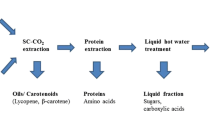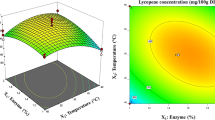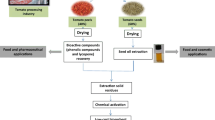Abstract
Large amounts of a waste known as tomato pomace and consisting mainly of the fruit peel and seeds are generated annually from the industrial processing of tomatoes. This material is rich in lycopene, a phytochemical with antioxidant and chemopreventive properties, and contains many valuable nutrients. In this study, we have investigated the possibility of using the whole waste to produce a lycopene-enriched seed oil. The oil was obtained by cold-pressing the seeds and was subsequently enriched in lycopene (up to 500 ppm) by incorporation of a tomato oleoresin derived from the peels. To increase lycopene recovery, the peels were pretreated with cell-wall-degrading enzymes and solvent extracted. This procedure allowed the production of about 25 kg/ton oleoresin with an average lycopene content of 6.8 wt.%. The compositional characteristics of the oil combined with the production of significant amounts of oleoresin strongly support the use of tomato pomace for producing lycopene-based functional products.








Similar content being viewed by others
References
Altan, A., McCarthy, K. L., & Maskana, M. (2008). Evaluation of snack foods from barley–tomato pomace blends by extrusion processing. Journal of Food Engineering, 84, 231–242.
Andreassi, L. (2011). UV exposure as a risk factor for skin cancer. Expert Review of Dermatology, 6, 445–454.
Anunciato, T. P., & da Rocha Filho, P. A. (2012). Carotenoids and polyphenols in nutricosmetics, nutraceuticals and cosmeceuticals. Journal of Cosmetic Dermatology, 11, 51–54.
Bovy, A., Schijlen, E., & Hall, R. D. (2007). Metabolic engineering of flavonoids in tomato (Solanum lycopersicum): the potential for metabolomics. Metabolomics, 3, 399–412.
Caris-Veyrat, C. C., Schmid, A., Carail, M., & Böhm, V. (2003). Cleavage products of lycopene produced by in vitro oxidations: characterization and mechanisms of formation. Journal of Agricultural and Food Chemistry, 51, 7318–7325.
Carlson, B. L., Knorr, D., & Watkins, T. R. (1981). Influence of tomato seed addition on the quality of the wheat flour breads. Journal of Food Science, 46, 1029–1031.
Chen, B., McClements, D. J., & Decker, E. A. (2011). Minor components in food oils: a critical review of their roles on lipid oxidation chemistry in bulk oils and emulsions. Critical Reviews in Food Science and Nutrition, 51, 901–916.
Choe, E., & Min, D. B. (2009). Mechanisms of antioxidants in the oxidation of foods. Comprehensive Reviews in Food Science and Food Safety, 8, 345–358.
Codex Alimentarius Commission. (2005). CODEX standard for named vegetable oils, CODEX STAN 210. Rome: Food and Agriculture Organisation of the United Nations.
Del Valle, M., Cámara, M., & Torija, M. E. (2006). Chemical characterization of tomato pomace. Journal of the Science of Food and Agriculture, 86, 1232–1236.
Demirbas, A. (2010). Oil, micronutrient and heavy metal contents of tomatoes. Food Chemistry, 118, 504–507.
Di Mascio, P., Kaiser, S., & Sies, H. (1989). Lycopene as the most efficient biological carotenoid singlet oxygen quencher. Archives of Biochemistry and Biophysics, 274, 532–538.
Ekthamasut, K. (2006). Effect of tomato seed meal on wheat pasting properties and alkaline noodle qualities. Australian Journal of Technology, 9, 147–152.
Eller, F. J., Moser, J. K., Kenar, J. A., & Taylor, S. L. (2010). Extraction and analysis of tomato seed oil. Journal of the American Oil Chemists' Society, 87, 755–762.
Fielding, J. M., Rowley, K. G., Cooper, P., & O’Dea, K. (2005). Increases in plasma lycopene concentration after consumption of tomatoes cooked with olive oil. Asia Pacific Journal of Clinical Nutrition, 14, 131–136.
Fish, W. W., Perkins-Veazie, P., & Collins, J. K. (2002). A quantitative assay for lycopene that utilizes reduced volumes of organic solvents. Journal of Food Composition and Analysis, 15, 309–317.
Giannelos, P. N., Sxizas, S., Lois, E., Zannikos, F., & Anastopoulos, G. (2005). Physical, chemical and fuel related properties of tomato seed oil for evaluating its direct use in diesel engines. Industrial Crops and Products, 22, 193–199.
González, S., Fernandez-Lorente, M., & Gilaberte-Calzada, Y. (2008). The latest on skin photoprotection. Clinics in Dermatology, 26, 614–616.
Hetzroni, A., Vana, A., & Mizrach, A. (2011). Biomechanical characteristics of tomato fruit peels. Postharvest Biology and Technology, 59, 80–84.
Kelkel, M., Schumacher, M., Dicato, M., & Diederich, M. (2011). Antioxidant and anti-proliferative properties of lycopene. Free Radical Research, 45, 925–940.
Khachik, F., Carvalho, L., Bernstein, P. S., Muir, G. J., Zhao, D. Y., & Katz, N. B. (2002). Chemistry, distribution, and metabolism of tomato carotenoids and their impact on human health. Experimental Biology and Medicine, 227, 845–851.
Kochhar, S. P. (2000). Stabilisation of frying oils with natural antioxidative components. European Journal of Lipid Science and Technology, 102, 552–559.
Köckritz, A., & Martin, A. (2008). Oxidation of unsaturated fatty acid derivatives and vegetable oils. European Journal of Lipid Science and Technology, 110, 812–824.
Kong, K. W., Khoo, H. E., Prasad, K. N., Ismail, A., Tan, C. P., & Rajab, N. F. (2010). Revealing the power of the natural red pigment lycopene. Molecules, 15, 959–987.
Kucuk, O., Sarkar, F. H., Sakr, W., Djuric, Z., Pollak, M. N., Khachik, F., et al. (2001). Phase II randomized clinical trial of lycopene supplementation before radical prostatectomy. Cancer Epidemiology, Biomarkers & Prevention, 10, 861–868.
Lavecchia, R., & Zuorro, A. (2008). Improved lycopene extraction from tomato peels using cell-wall degrading enzymes. European Food Research and Technology, 228, 153–158.
Lazos, E. S., Tsaknis, J., & Lalas, S. (1998). Characteristics and composition of tomato seed oil. Grasas y Aceites, 49, 440–445.
Leclercq, S., Reineccius, G. A., & Milo, C. (2007). Effect of type of oil and addition of δ-tocopherol on model flavor compound stability during storage. Journal of Agricultural and Food Chemistry, 55, 9189–9194.
Loizou, S., Lekakis, I., Chrousos, G. P., & Moutsatsou, P. (2010). Beta-sitosterol exhibits anti-inflammatory activity in human aortic endothelial cells. Molecular Nutrition & Food Research, 54, 551–558.
Longo, C., Leo, L., & Leone, A. (2012). Carotenoids, fatty acid composition and heat stability of supercritical carbon dioxide-extracted-oleoresins. International Journal of Molecular Sciences, 13, 4233–4254.
Majzoobi, M., Ghavi, F. S., Farahnaky, A., Jamalian, J., & Mesbahi, G. (2011). Effect of tomato pomace powder on the physicochemical properties of flat bread (Barbari bread). Journal of Food Processing and Preservation, 35, 247–256.
Myers, R. H., & Montgomery, D. C. (1995). Response surface methodology. Process and product optimization using designed experiments. New York: Wiley.
Offord, E. A., Gautier, J. C., Avanti, O., Scaletta, C., Runge, F., Krämer, K., et al. (2002). Photoprotective potential of lycopene, β-carotene, vitamin E, vitamin C and carnosic acid in UVA-irradiated human skin fibroblasts. Free Radical Biology & Medicine, 32, 1293–1303.
Omoni, A. O., & Aluko, R. E. (2005). The anti-carcinogenic and anti-atherogenic effects of lycopene: a review. Trends in Food Science and Technology, 16, 344–350.
Park, C., Moon, D., Rhu, C. H., Choi, B. T., Lee, W. H., Kim, G. Y., et al. (2007). β-Sitosterol induces anti-proliferation and apoptosis in human leukemic U937 cells through activation of caspase-3 and induction of Bax/Bcl-2 ratio. Biological & Pharmaceutical Bulletin, 30, 1317–1323.
Rao, A. V., & Ali, A. (2007). Biologically active phytochemicals in human health: lycopene. International Journal of Food Properties, 10, 279–288.
Rao, A. V., & Shen, H. (2002). Effect of low dose lycopene intake on lycopene bioavailability and oxidative stress. Nutrition Research, 22, 1125–1131.
Rao, A. V., Raym, M. R., & Rao, L. G. (2006). Lycopene. Advances in Food and Nutrition Research, 51, 99–164.
Riccioni, G., Mancini, B., Di Ilio, E., Bucciarelli, T., & D’Orazio, N. (2008). Protective effect of lycopene in cardiovascular disease. European Review for Medical and Pharmacological Sciences, 12, 183–190.
Rittié, L., & Fisher, G. J. (2002). UV-light-induced signal cascades and skin aging. Ageing Research Reviews, 1, 705–720.
Roy, B. C., Goto, M., & Hirose, T. (1996). Temperature and pressure effects on supercritical CO2 extraction of tomato seed oil. International Journal of Food Science and Technology, 31, 137–141.
Rozzi, N. L., Singh, R. K., Vierling, R. A., & Watkins, B. A. (2002). Supercritical fluid extraction of lycopene from tomato processing by-products. Journal of Agricultural and Food Chemistry, 50, 2638–2643.
Ryan, L., Mestrallet, M. G., Nepote, V., Conci, S., & Grosso, N. R. (2008). Composition, stability and acceptability of different vegetable oils used for frying peanuts. International Journal of Food Science and Technology, 43, 193–199.
Sabio, E., Lozano, M., Montero de Espinosa, V., Mendes, R. L., Pereira, A. P., Palavra, A. F., et al. (2003). Lycopene and β-carotene extraction from tomato processing waste using supercritical CO2. Industrial and Engineering Chemistry Research, 42, 6641–6646.
Seren, S., Lieberman, R., Bayraktar, U. D., Heath, E., Sahin, K., Andic, F., et al. (2008). Lycopene in cancer prevention and treatment. American Journal of Therapeutics, 15, 66–81.
Sharma, S. K., & LeMaguer, M. (1996). Lycopene in tomatoes and tomato pulp fractions. Italian Journal of Food Science, 2, 107–113.
Shen, X., & Xu, S. (2005). Supercritical CO2 extraction of tomato seed oil. Journal of Food Technology, 3, 226–231.
Shi, J., LeMaguer, M., Mazza, G. (2002). Lycopene from tomatoes. In Functional foods (pp. 135–167). Boca Raton: CRC.
Shixian, Q., Dai, Y., Kakuda, Y., Shi, J., Mittal, G., Yeung, D., et al. (2005). Synergistic anti-oxidative effects of lycopene with other bioactive compounds. Food Reviews International, 21, 295–311.
Sies, H., & Stahl, W. (1998). Lycopene: antioxidant and biological effects and its bioavailability in the human. Proceedings of the Society for Experimental Biology and Medicine, 218, 121–124.
Sogi, D. S., Sidhu, J. S., Arora, M. S., Garg, S. K., & Bawa, A. S. (2002). Effect of tomato seed meal supplementation on dough and bread characteristics of wheat (PBW-343) flour. International Journal of Food Properties, 5, 563–571.
Spanos, G. A., Chen, H., & Schwartz, S. J. (1992). Supercritical CO2 extraction of β-carotene from sweet potatoes. Journal of Food Science, 38, 817–820.
Stahl, W., Heinrich, U., Aust, O., Tronnier, H., & Sies, H. (2006). Lycopene-rich products and dietary photoprotection. Photochemical & Photobiological Sciences, 5, 238–242.
Strati, I. F., & Oreopoulou, V. (2011). Effect of extraction parameters on the carotenoid recovery from tomato waste. International Journal of Food Science and Technology, 46, 23–29.
van het Hof, K. H., West, C. E., Weststrate, J. A., & Hautvast, J. G. A. J. (2000). Dietary factors that affect the bioavailability of carotenoids. Journal of Nutrition, 130, 503–506.
Van Hoed, V. (2010). Phenolic compounds in seed oil. Lipid Technology, 22, 247–249.
WPTC (2011). World production estimate as of 21 October 2011, Release # 38. http://www.wptc.to/releases/releases38.pdf. Accessed 18 June 2012.
Xianquan, S., Shi, J., Kakuda, Y., & Yueming, J. (2005). Stability of lycopene during food processing and storage. Journal of Medicinal Food, 8, 413–422.
Zhao, Y., Chang, S. K., Qu, G., Li, T., & Cui, H. (2009). Beta-sitosterol inhibits cell growth and induces apoptosis in SGC-7901 human stomach cancer cells. Journal of Agricultural and Food Chemistry, 24, 5211–5218.
Zuorro, A., & Lavecchia, R. (2010). Mild enzymatic method for the extraction of lycopene from tomato paste. Biotechnology and Biotechnological Equipment, 24, 1854–1857.
Zuorro, A., Fidaleo, M., & Lavecchia, R. (2011). Enzyme-assisted extraction of lycopene from tomato processing waste. Enzyme and Microbial Technology, 49, 567–573.
Author information
Authors and Affiliations
Corresponding author
Rights and permissions
About this article
Cite this article
Zuorro, A., Lavecchia, R., Medici, F. et al. Enzyme-Assisted Production of Tomato Seed Oil Enriched with Lycopene from Tomato Pomace. Food Bioprocess Technol 6, 3499–3509 (2013). https://doi.org/10.1007/s11947-012-1003-6
Received:
Accepted:
Published:
Issue Date:
DOI: https://doi.org/10.1007/s11947-012-1003-6




